Metro Station Hours in Dubai: A Detailed Guide
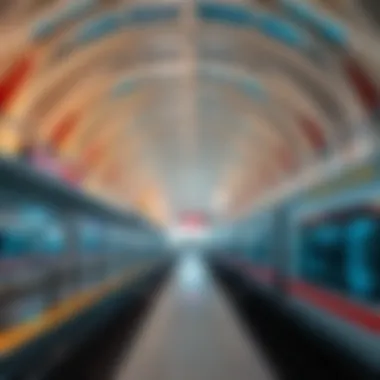
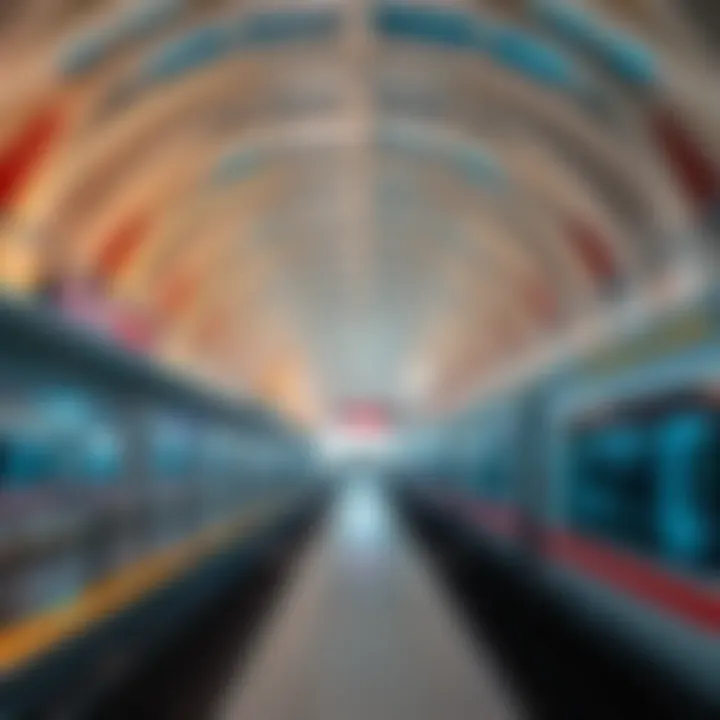
Intro
Navigating the bustling city of Dubai can be quite the experience, especially for newcomers and tourists trying to make sense of its extensive metro system. The metro offers a convenient lifeline, not just for residents darting to work but also for tourists seeking to explore the dazzling emirate. Understanding the opening times of these metro stations is crucial for anyone looking to optimize their daily commuting and travel plans.
From the crack of dawn to the late hours of the night, each line of the metro runs like clockwork, but slight variations can be found between weekdays and weekends or during public holidays. With the right knowledge, riders can avoid the rush and plan their journeys effectively. Furthermore, the opening hours of metro stations significantly impact surrounding areas—an aspect that real estate investors and homebuyers should keep a close eye on.
This article aims to delve deep into metro station opening times in Dubai, explore why these timings matter, and how they can influence travel patterns, business operations, and even the local property market. Keeping your ear to the ground about these details is essential for making informed decisions, especially for investors seeking high-return areas.
Get ready to explore the details that can make or break your travels and investments in this sparkling metropolis.
Prelude to Dubai's Metro System
Dubai's Metro System stands as a hallmark of the city’s rapid development. It's not just a mode of transportation; it reflects the ambitions of a metropolis aiming for connectivity and efficiency. As urbanization pushes limits, this metro system addresses the pressing needs of both locals and visitors, allowing for a seamless experience in the bustling city. When one contemplates the importance of metro opening times, it becomes evident how they serve as a backbone of daily life, impacting everything from commuter flow to business operations.
Historical Context of Dubai Metro
The inception of Dubai's Metro dates back to the early 2000s, a time when the city's skyline was under transformation. The idea to develop a mass transit system was rooted in escalating traffic congestion and the desire to promote public transport usage. After the groundbreaking ceremony in 2006, the metro began its journey, and eight years later, in 2014, the system became a significant part of daily commutes for many. Looking back, one can see how essential this transport solution has been in shaping the urban landscape of Dubai. The full operational capacity of the Red and Green lines offers over 75 kilometers of route, brimming with stations that cater to a diverse population.
Importance of Metro in Urban Mobility
The metro system plays a crucial role in urban mobility, supporting the smooth flow of people across the city. In a place like Dubai, marked by extraordinary growth, the emphasis on an efficient public transport system cannot be overstated. Metro stations act like arteries, circulating commuters, tourists, and professionals throughout the urban environment.
The specifics of metro opening hours directly influence commuter behavior. During peak hours, which generally span from early morning until late evening, stations experience significant activity. This ensures that the flow of passengers is consistent and timely, making it easier for businesses to thrive nearby. The connectivity fosters higher foot traffic, benefitting commercial establishments while offering residents the mobility necessary for everyday life.
Moreover, by providing an alternative to personal vehicles, the metro aids in reducing traffic congestion, consequently lowering pollution levels. This is markedly important in a city that prides itself on sustainability and innovative technologies. All of these factors underline the metro's pivotal role in the urban framework, revealing how opening times are not merely a detail—they are instrumental in shaping daily routines and economic prosperity.
"Public transport like the metro in Dubai opens pathways that can change the flow of life in a bustling city, proving that timing is everything in urban planning."
By understanding the historical context and the vital importance of the metro in urban mobility, we can appreciate the nuanced role that opening hours play in this sprawling city. For residents and tourists alike, knowing when and how to access the metro can make all the difference, enhancing their ability to navigate Dubai effortlessly.
General Opening Times of Metro Stations
In Dubai, the metro system is more than just a mode of transport; it is a pulsating vein of urban mobility. Understanding the general opening times of metro stations is crucial for both residents and visitors alike. The hours of operation can significantly influence daily commuting, business operations, and overall urban movement throughout the city. Especially for investors and homebuyers keen on real estate trends, the timing of the metro can impact property values and desirability.
When you're able to rely on consistent metro hours, it can streamline your daily routines. Whether you’re commuting to work, heading out for leisure, or embarking on a shopping spree, knowledge of the opening times fosters confidence and efficiency in travel plans. Additionally, aligning your schedule with metro hours is a vital aspect of navigating the dynamism of Dubai's bustling lifestyle.
Standard Opening Hours
The standard corridors of operation for Dubai’s metro stations embody a well-orchestrated blend of accessibility and convenience. Typically, the metro opens around 6:00 AM during weekdays and can hold its own until about midnight. These standard hours cater to early risers commuting to work as well as night owls enjoying the vibrant nightlife of Dubai.
For a sharper perspective, remember:
- Monday to Thursday: 6:00 AM to midnight
- Friday: 6:00 AM to 1:00 AM next day
- Saturday: 6:00 AM to midnight
- Sunday: 6:00 AM to midnight
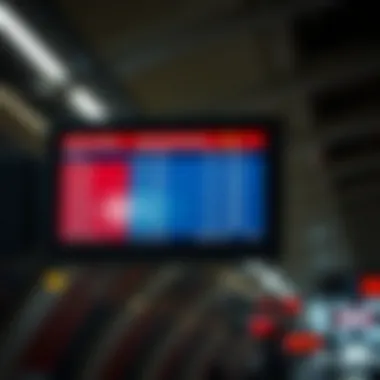
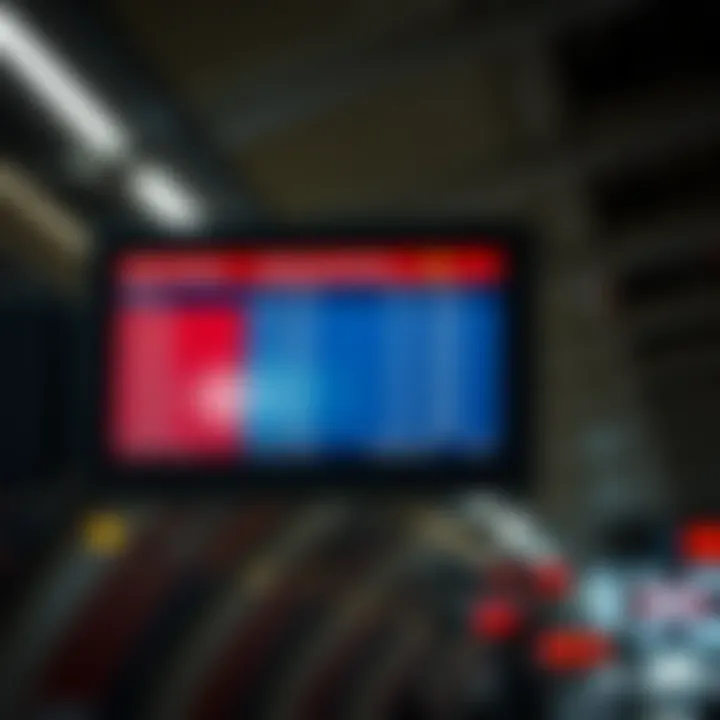
These times might sound consistent, yet they play a crucial role in seamless mobility across the emirate. If you miss the last train, the frustration could be palpable. Knowing that the metro aligns with your engagements is a sigh of relief.
Variations During Weekends
Weekends in Dubai, particularly Friday and Saturday, show a noteworthy variance in metro operational hours. With many residents making the most of their time off, the metro extends its services later on Fridays, accommodating the late-night crowd. After a long week, it's not uncommon for locals and tourists alike to indulge in a night out, and metro service extending past midnight provides a safe and reliable means of traveling home.
To illustrate:
- Friday's extended hours not only cater to the night scene but also encompass shopping trips, family outings, and cultural activities that typically peak during these days. This is a fine testament to how metro hours adapt and evolve based on societal needs.
Public Holiday Adjustments
Public holidays in Dubai also see adjustments to metro schedules. These changes are pivotal for accommodating an increased volume of passengers. During holidays, whether it be Eid, National Day, or other significant events, the metro might operate with longer hours or increased frequency.
"Adapting metro schedules to cater to public holidays is crucial for promoting accessibility and supporting those who wish to partake in city-wide celebrations without the hassle of road traffic."
Investors and developers should keep an eye on such patterns since they reflect broader trends in commuter behavior. Understanding how people utilize metro services during holidays provides insights into potential real estate opportunities, particularly around popular venues or neighborhoods.
As you peruse these operational specifics, consider how they affect not only personal travel but the larger landscape of urban mobility and real estate dynamics in Dubai.
Factors Influencing Metro Opening Hours
The operation of metro stations is not simply a matter of clocking in and out; several factors come into play that determine when these services are running. Understanding these influences offers vital knowledge for anyone navigating the intricacies of urban transport in Dubai. From the demand for passenger services to the ongoing urban development projects shaping the city, these factors play a key role in how metro hours are structured. Grasping these elements not only aids commuters but also provides insights for investors and stakeholders in real estate. Their decisions can significantly benefit from the timing and availability of metro operations.
Passenger Demand Analysis
A direct link exists between opening hours and passenger demand, which fluctuates based on several considerations. For instance, during peak periods — think early morning commutes or rush hour evenings — you might spot longer intervals between trains. This setup caters to a larger number of commuters while ensuring that every passenger can hop on without a lengthy wait. Popular routes see a spike in activity during weekends too, when leisure-driven travelers seek entertainment options across the city.
Moreover, special events such as festivals or exhibitions can drastically alter demand histograms. Metro authorities often adjust schedules in response to these external factors, employing strategic measures to match passenger needs. Analysis of boarding data collected over months could indicate these patterns, showing when stations fill to the brim or are eerily quiet. Thus, keeping an eye on reports can be advantageous for anyone looking to avoid the crush or strategically plan a visit.
Urban Development Projects Impact
Urban development projects are more than just bricks and mortar; they directly influence how metro services operate. New residential or commercial constructions can lead to an uptick in new commuters, prompting a review of existing service times. For instance, if a new mall opens adjacent to a station, the authorities might consider extending hours or adding more trains to accommodate increased foot traffic.
Additionally, initiatives focused on enhancing livability in the business core of Dubai often require collaboration with metro services to ensure seamless public transport options. Corporate hubs sprouting up can change the city’s socio-economic landscape, necessitating an agile response from metro operations. Therefore, keeping informed about these projects not only aids in travel planning but also opens doors for real estate investments. Those interested in property investments would do well to consider locations near developing metro lines, which could increase property value over time.
The Role of Metro in Real Estate Investment
As Dubai's skyline continues to evolve, the intertwining of metro accessibility with real estate investment becomes increasingly significant. The metro system not only facilitates convenient transportation but also enhances the desirability and value of properties nearby. Investors and homebuyers alike are considering proximity to metro stations as a key factor in their decisions.
Property Trends Near Metro Stations
In recent years, there has been a noticeable uptick in construction and property development around metro stations. Areas once considered remote are now buzzing with new developments, transforming the landscape.


- Increased Demand for Residential Units: As the population of Dubai grows, so does the appetite for housing. Proximity to a metro station often becomes a major selling point for residential developments. This demand often leads to a premium on prices, making properties near these stations more attractive for investors.
- Commercial Developments Flourishing: The outskirts near metro stations are ideal for commercial ventures. Shopping malls, offices, and service retail outlets tend to flourish in such locales, taking advantage of the constant foot traffic generated by commuters. Investors are keen to capitalize on this trend, as the potential for high returns becomes evident.
- Urban Planning and Development: Dubai’s urban planners are not oblivious to the correlation between metro lines and real estate growth. Projects like Dubai Creek Harbor and Deira Waterfront demonstrate how strategic metro placements can stimulate nearby property markets.
In noticing these trends, one can understand why savvy investors are placing bets on properties surrounding metro lines.
Impact on Rental Prices
Understanding how rental prices fluctuate in relation to metro accessibility is essential for both investors and tenants.
- Higher Rental Yields: Properties located near metro stations tend to command higher rents. Individuals seeking to live in prime locations, with easy access to transport, are typically willing to pay a premium. This elevated demand contributes to higher rental yields for property owners.
- Stabilized Rental Markets: Areas close to metro stations also show more rental price stability. When compared with neighborhoods farther away from the transit system, properties near metro lines are less susceptible to price drops during market downturns. This resilience can be a major draw for long-term investors.
- Attractiveness to Expats and Young Professionals: There’s a continued influx of expatriates and younger professionals moving to Dubai. Many of these individuals prefer properties within walking distance to metro stations. This ever-gaining demographic shifts the rental landscape, pushing prices upward.
"Proximity to metro stations isn't just a luxury; it's a solid investment criterion in Dubai's evolving real estate market."
By understanding these dynamics, investors can better align their strategies with the reality of the market. The interconnection between the metro system and real estate development in Dubai illuminates not only the practical aspects of commuting but also the potential for profitable investments in a rapidly developing urban landscape.
Planning Your Journey Effectively
When traveling in a bustling city like Dubai, understanding the metro station opening times is paramount for efficient navigation. Many residents and visitors rely on the metro system as a primary means of transport, which makes it essential to plan journeys meticulously. Knowing when the metro operates can save time, enrich experiences, and even bolster investments in real estate around these transit hubs.
Using Apps for Real-Time Updates
In an age where smartphones are almost an extension of ourselves, leveraging technology can make a significant difference in your daily commute. Various apps provide real-time updates regarding metro timings and schedules. For instance, the RTA (Roads and Transport Authority) app offers a user-friendly interface that delivers crucial information, like train delays or service interruptions. Getting a heads-up before heading to the station can save you from unforeseen hassles.
Furthermore, some apps include features like route planning, which can help you choose the most efficient way to your destination. These resources are particularly valuable during busy hours when trains are packed and waiting times can stretch. Imagine standing on a platform, unsure whether to hop on the next train or wait for an empty one. Having up-to-the-minute info can eliminate those nagging anxieties.
Using apps doesn’t only assist with meticulous journey planning; it also enhances the overall metro experience.
Integrating Metro with Other Transport
Dubai’s metro is a cog in a broader transportation machine, connecting seamlessly with various modes of transit. Understanding how to integrate metro journeys with buses or taxis can significantly amplify the efficiency of your travels. Each metro station in Dubai is typically located near bus stops or taxi ranks, so a little planning goes a long way.
- Buses: Utilizing buses alongside the metro can be a cost-effective solution. Many bus routes link directly to metro stations, enabling easy transitions. For example, catching a bus from a neighborhood to the nearest metro station can streamline your trip downtown, perhaps to Business Bay or Dubai Mall.
- Taxis and Ride-Sharing Services: On days when you need faster or more direct transit, taxis or ride-sharing services like Careem can serve as a reliable backup when metro service does not align with your timing needs.
Merging these transport modes not only saves valuable minutes but also opens up new routes that the metro alone may not cover. The holistic view of the transport network is pivotal in a city that’s constantly progressing.
Key Takeaway: Planning journeys effectively requires not only knowledge of metro timings but also an understanding of how to maximize the city's transport offerings. With apps and a coherent transport strategy, navigating through Dubai can transform from a cluttered experience to a smooth sail.
Sustainable Practices in Metro Operations
Sustainable practices in metro operations are a crucial aspect of urban transport, especially in a rapidly evolving metropolis like Dubai. As the city continues to expand, the push for environmentally friendly transportation methods becomes more significant. Understanding this not only informs residents and tourists of operational efficiencies but also attracts investors and policy-makers interested in sustainable urban development.
Environmental Benefits of Metro Transportation
Metro transportation offers several environmental benefits that contribute to the reduction of carbon footprints. Unlike road transportation, which often relies heavily on gasoline and diesel, metro systems like Dubai’s use electric trains, which can be powered by renewable energy sources. Some of the most notable advantages include:
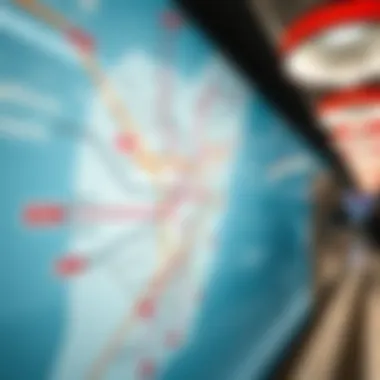
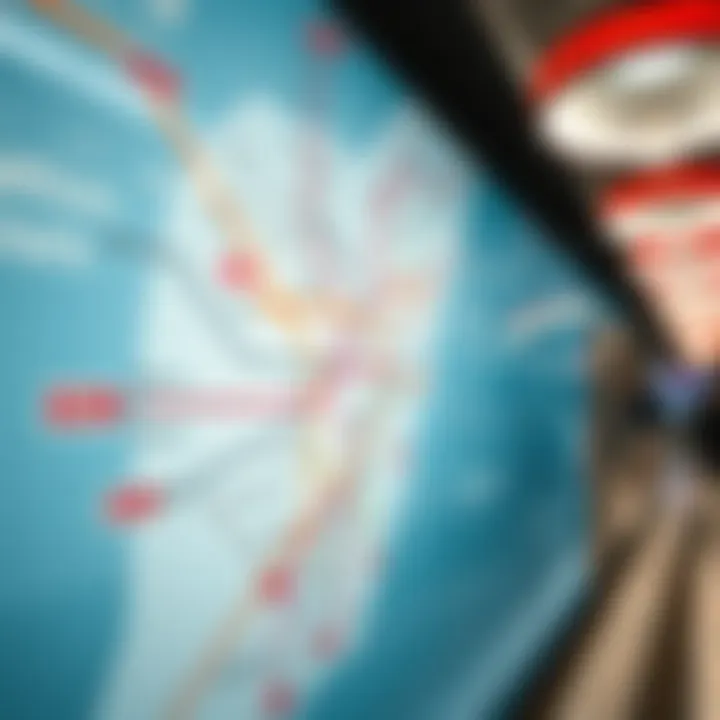
- Reduction in Air Pollution: By shifting more commuters to the metro, it results in fewer cars on the road, which diminishes harmful emissions.
- Energy Efficiency: Electric systems are generally more efficient than combustion engines. For every passenger, metros consume significantly less energy and create less environmental impact.
- Land Use Efficiency: Metro systems encourage higher-density developments along their routes, which helps create compact urban areas. This can preserve green spaces and reduce urban sprawl.
"Public transport is the backbone of any sustainable city, reducing congestion and contributing to cleaner air."
These benefits are not just environmental; they also translate into economic savings for both the municipality and its residents. With lower healthcare costs related to air quality, and substantial savings on transport infrastructure in comparison to building more roads, the metro represents a long-term investment in urban sustainability.
Future of Eco-friendly Transport Solutions
Looking ahead, the future of eco-friendly transport solutions in Dubai's metro system appears promising. With ongoing advancements in technology and an increasing focus on green initiatives, several trends are emerging:
- Integration of Smart Technologies: By implementing smart traffic management systems that link metro schedules with real-time data, the flow of passengers can be optimized. This reduces idle times and maximizes efficiency.
- Electric and Hybrid Train Systems: As technology progresses, there’s potential to employ more electric and hybrid trains. This move would further decrease reliance on fossil fuels and lower total energy consumption.
- Infrastructure Innovations: Continuous upgrades in infrastructure, including better energy capture systems and sustainable building materials for stations, are key to enhancing the metro's sustainability profile.
- Public Engagement and Awareness: Encouraging eco-friendly travel through campaigns can increase public buy-in. When the community understands the benefits of using the metro, they are more likely to change their commuting habits.
Challenges Ahead for Metro Operations
Navigating through the complexities of Dubai's metro system entails understanding not just its operational accomplishments but the challenges it might face in the future. As the city continues to grow at an astonishing pace, the metro must adapt to keep up. From infrastructure maintenance needs to ensuring passenger safety, these factors play a significant role in determining how smoothly the system operates. Addressing these challenges isn’t just a logistical issue; it’s about enhancing the overall experience for both residents and visitors in this bustling metropolis.
Infrastructure Maintenance and Upgrades
The foundation of a robust metro system lies in its infrastructure. Over time, wear and tear can take a toll on the trains, tracks, and stations. Regular maintenance and necessary upgrades are essential to avoid unexpected disruptions. A well-maintained metro ensures reliability—a critical factor for daily commuters. Infrastructure work might lead to temporary closures or adjusted schedules, so it’s crucial for the operators to communicate these changes in advance to maintain passenger trust.
It’s interesting to note that infrastructure concerns often align with urban development projects. As new skyscrapers rise and neighborhoods evolve, the metro must expand or modify its services to effectively link with these developments. This becomes a balancing act: on one hand, you have immediate maintenance goals, and on the other, long-term visions for a comprehensive transit network.
Passenger Safety and Security Protocols
When it comes to public transportation, passenger safety should be at the forefront. For Dubai’s metro system, this means implementing stringent security measures. The presence of security personnel, CCTV systems, and emergency procedures are essential aspects of ensuring a safe environment for all travelers. Given the large volume of passengers using the system daily, effective crowd management strategies must also be prioritized.
"Safety isn’t just a priority; it should be a guarantee for every passenger traveling in the metro."
With recent global events underscoring the importance of security in public spaces, continually updating safety protocols must be a priority for metro management. This could also involve collaboration with local authorities to run emergency drills and training sessions, assuring that staff are well-prepared for any situation. Moreover, transparency about safety measures can help bolster public confidence in the metro system as a safe travel option.
In tackling these challenges, Dubai's metro operations glimpse at a promising future, not just in efficiency but in the level of service provided. Addressing infrastructure maintenance and prioritizing passenger safety creates a framework for a successful and sustainable metro operation.
Epilogue and Future Insights
As we reflect upon the intricacies of Dubai's metro station opening times, it’s clear that this subject extends far beyond mere commuting schedules. The operational hours of these metro stations weave a fabric that influences daily life, urban mobility, and even the pulse of the local economy. Understanding how these hours fluctuate and why they hold significance is essential for residents and visitors alike. The impact of transportation on business operations, tourism, and urban development cannot be underestimated. A well-timed visit to a certain business in the heart of a bustling neighborhood can hinge directly on the availability of metro services.
Moreover, as Dubai continues to expand and evolve, the future of its metro system is likely to follow suit. Enhanced accessibility through targeted adjustments in opening times can potentially pave the way for greater passenger satisfaction and improved operational efficiency. Projects currently underway could lead to additional metro stations, which will also affect opening hours in unforeseen ways. This presents an important opportunity for stakeholders—be they investors, developers, or commuters—to stay attuned to these dynamics.
Next Steps in Metro Development
As Dubai's metro system develops, several next steps can materialize:
- Expansion Plans: With the Dubai Expo 2020 showcasing the city on a global stage, plans for extending existing metro lines and adding new stations are in full swing. Understanding the anticipated timelines for these constructions and how they impact current operations will be crucial for anyone depending on metro service.
- Community Engagement: Involving public feedback in planning processes can result in more responsive service. Stakeholders should advocate for community meetings, where residents can voice their needs, thus tailoring the metro services to meet real-world demands.
- Integration of Multi-modal Transport: As the metro expands, the integration of various transport modes becomes crucial. Effective strategies can include promoting easier transfers between buses, taxis, and the metro, thus creating a seamless travel experience.
The Impact of Smart Technology
Smart technology is reshaping how transport networks, including metros, operate. Here's why this is a pivotal area to watch:
- Real-Time Data: Smart systems can provide real-time updates on train schedules and delays, which significantly enhances commuter experiences. This data is invaluable—if a metro train arrives late, commuters can adjust their plans accordingly.
- Sustainability Improvements: Technology can play an important role in energy usage, helping to lower operational costs. By implementing smart grids and energy-efficient systems, metro operators can promote eco-friendly practices, aligning with global sustainability trends.
- Enhanced Safety Features: Innovations in monitoring technologies could lead to enhancements in safety protocols. Such measures are essential for maintaining public confidence and ensuring that commuters can navigate the metro system without worry.



